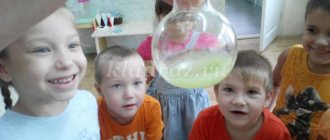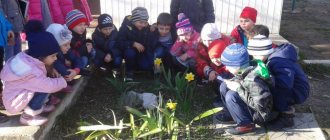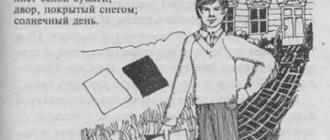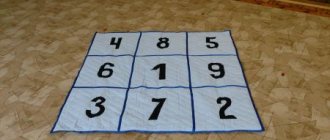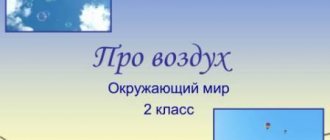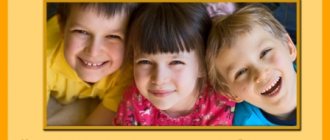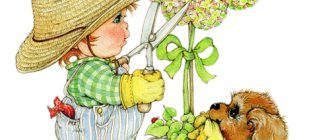Card index of experiences and experiments for children of senior preschool age
CARD FILE OF EXPERIMENTS AND EXPERIMENTS FOR SENIOR PRESCHOOL CHILDREN
Target:
— To promote the development in children of cognitive activity, curiosity, the need for children’s mental impressions, the desire for independent knowledge and reflection.
— Teaching children research activities: the ability to see a problem;
formulate and ask questions; put forward hypotheses; draw conclusions and
inferences; prove and defend your ideas; on one's own
act during the research stages.
— Development in children of senior preschool age the ability to see the diversity of the world in a system of relationships and interdependence;
— Development of mental cognitive processes, expansion of the child’s vocabulary.
1st WEEK OF SEPTEMBER
SUMMER IS PASSED
"Sand Cone"
Release handfuls of sand so that it falls in one place. Gradually, at the place where the sand falls, a cone is formed, growing in height and occupying an increasingly larger area at the base. If you pour sand on the surface of the cone for a long time, first in one place, then in another, “floats” occur, movements of the sand similar to the flow of water. This means that the sand can move. After the experience, ask if it is possible to build a permanent road in the sands.
2nd WEEK OF SEPTEMBER
BEAUTY IS AROUND US
"Rainbow"
Equipment
: a plate of water, nail polish, a “fishing rod” for film. Place a drop of varnish into the water. A thin film forms on the surface of the water. It must be carefully removed using a special device - a “fishing rod”. The varnish film will play with all colors, reminiscent of the wings of a dragonfly. A ray of white light hitting a thin film is partially reflected from it, and partially travels deeper, reflecting from its inner surface.
3-4 WEEK OF SEPTEMBER
AUTUMN
“Fruits: how can you eat them?”
Target:
Show children different ways to cook with fruit.
Materials and equipment
. Pictures depicting fruits, a plot picture “Harvesting in the garden”, plates with dried fruits, canned and fresh fruits, glasses with fruit compote.
Move.
The teacher and the children look at pictures of fruits and a plot picture. The teacher asks the children what is the difference between fruits and vegetables. Next, the teacher invites the children to look at raw fruits and asks how else a person came up with the idea of eating them and why.
Together with the children, the teacher examines and tastes dried and canned fruits and drinks compote. Everyone compares how these products differ and draws a conclusion.
Children learn to find the same fruit, prepared differently, and determine the difference in taste.
Conclusion.
Man came up with the idea of preparing fruit for the winter in different ways: drying, canning, boiling. Fruits contain a lot of vitamins that are beneficial to our body. But fresh fruits are the healthiest - they contain all the vitamins.
“WHY DO THE LEAVES TURN YELLOW IN AUTUMN?”
Target:
Show the relationship between leaf color and a decrease in the thermal factor for the plant.
Materials and equipment
. Rowan growing next to a kindergarten, weather calendar, outdoor thermometer, temperature graph. (The experience is delayed in time for 2-3 months).
Move.
Together with the teacher, children observe the colors of rowan leaves and the air temperature. Their observations are recorded in the calendar and temperature chart.
Result.
The leaves turn yellow when the temperature drops.
Conclusion
. In autumn there is always a period when the days are still long and the heat becomes less. The plant would have enough light for further development, but everything is slowed down due to low temperatures. Then pigments appear in the leaves that help trap heat - red, orange, yellow. This allows them to extend their life for a few more weeks.
1-2 WEEK OF OCTOBER
KINDERGARTEN. MY FRIENDS.
“HOW DOES A SONG APPEAR?”
—
Identify one of the reasons for the occurrence of high and low sounds, the dependence of sounding objects on their size.
-Xylophone, metallophone, wooden ruler.
The adult invites the children to play a simple melody (“chizhik-pyzhik”) on the instrument, then repeat the melody on a different register. Find out whether the songs sounded the same (the first time is softer; the second time is rougher). They pay attention to the size of the instrument’s pipes, repeat the same melody on high notes, and conclude: large pipes have a coarser (lower) sound, and small ones have a finer (higher) sound. The songs contain high and low notes.
“Why does everything sound?”
Task,
lead children to understand the causes of sound: vibration of an object.
Materials:
tambourine, glass beaker, newspaper, balalaika or guitar, wooden ruler, metallophone.
Description.
• Game “What does it sound like?” - the teacher invites the children to close their eyes, and he makes sounds using objects known to them. Children guess what it sounds like. Why do we hear these sounds? What is sound?
Children are asked to imitate in their voice:
what does a mosquito call?
(Z-z-z.)
How does a fly buzz?
(Zh-zh.)
How does a bumblebee buzz?
(Uh-uh.)
Then each child is invited to touch the string of the instrument, listen to its sound and then touch the string with his palm to stop the sound. What happened? Why did the sound stop?
The sound continues as long as the string vibrates. When she stops, the sound also disappears.
Does a wooden ruler have a voice?
Children are asked to make a sound using a ruler.
We press one end of the ruler to the table, and clap the free end with our palm. What happens to the ruler?
(Trembles, hesitates.)
How to stop the sound?
(Stop the ruler from oscillating with your hand.)
We extract sound from a glass glass using a stick and stop. When does sound arise?
The sound occurs when air moves back and forth very quickly.
This is called oscillation. Why does everything sound?
What other objects can you name that will sound? 3rd WEEK OF OCTOBER
IN THE WORLD OF ANIMALS (WORLD ANIMAL DAY)
“Can animals live in the ground?”
-Find out what is in the soil for the life of living organisms (Air, water, organic residues).
-Soil, alcohol lamp, metal plate, glass or mirror; container with water.
Children find out what animals need to live (breathing air, moisture), whether there is air, moisture, food in the soil. Preschoolers perform the following actions: immerse the soil in water (observe the release of air bubbles); heat the soil in a plate over an alcohol lamp, holding cooled glass over the soil (water droplets appear on it); heat the soil (the presence of organic residues is determined by smell). Children conclude that animals can live in the ground because it has air to breathe, food and moisture.
4TH WEEK OF OCTOBER
MY HOUSE (WORLD HOUSING, ARCHITECTURE DAY)
"World of Wood"
Task
- teach children to recognize things made of wood, introduce it to its qualities (hardness, surface structure - smooth or rough; degree of strength, thickness) and properties (cuts, burns, does not break, does not sink in water).
Materials and equipment
; wooden objects, containers with water, small planks and bars for each child; alcohol lamp, matches, knife, algorithm for describing the properties of the material (subject-schematic model).
Move
. The teacher shows several wooden objects and asks what is cut, burns, does not break, does not sink in water, and what the objects are made of. Offers to determine the quality of the material. To do this, each child receives a board and a block, feels them, and draws a conclusion about the surface structure and thickness. To reveal the properties of wood, he lowers the block into water (it doesn’t sink), drops it on the floor (it doesn’t break), and tries to break it (it doesn’t work, which means it’s durable). An adult tries to cut a block and focuses the children's attention on making great efforts to complete this work. Demonstrates the burning of wood. Creates an algorithm for describing the properties of materials. Children conclude: wood has certain qualities (hardness, surface structure, degree of strength), properties (cuts, burns, does not break, does not sink in water).
1st WEEK OF NOVEMBER
DAY OF NATIONAL UNITY
“Properties of air. Transparency."
We take a plastic bag, fill the bag with air and twist it. The bag is full of air, it looks like a pillow. The air took up all the space in the bag. Now let's untie the bag and let the air out of it. The bag has become thin again because there is no air in it. Conclusion: the air is transparent, to see it, you need to catch it.
2-3 WEEKS OF NOVEMBER
TRIPS. ROAD SAFETY.
“Where does water come from?”
Purpose: To introduce the condensation process.
Material: Hot water container, cooled metal lid.
An adult covers a container of water with a cold lid. After some time, children are invited to examine the inside of the lid and touch it with their hands. They find out where the water comes from (water particles rose from the surface, they could not evaporate from the jar and settled on the lid). The adult suggests repeating the experiment, but with a warm lid. Children observe that there is no water on the warm lid, and with the help of the teacher they conclude: the process of turning steam into water occurs when the steam cools.
“Why don’t ships sink?”
Lead the children to the conclusion why ships don’t sink. Place metal objects in a container of water and watch them sink. Place a tin can in the water, gradually loading it with metal objects. Children will make sure that the can will stay afloat.
4TH WEEK OF NOVEMBER
MOTHERS DAY
"BOILED OR RAW"
If there are two eggs on the table, one of which is raw and the other is boiled, how can you determine this? Of course, every housewife will do this with ease, but show this experience to a child - he will be interested. Of course, he is unlikely to connect this phenomenon with the center of gravity. Explain to him that a boiled egg has a constant center of gravity, so it rotates. And in a raw egg, the internal liquid mass acts as a kind of brake, so the raw egg cannot spin.
1st week of December
WINTER HAS COME
"Ice is lighter than water"
Place a piece of ice in a glass filled to the brim with water. The ice will melt, but the water will not overflow. Conclusion: The water that ice has turned into takes up less space than ice, meaning it is heavier.
2nd WEEK OF DECEMBER
Slightly - KA
"The Wizard Lemon"
Squeeze some lemon juice into a bowl and give it to your child
a white sheet of paper and a cotton swab and offer to write a letter for dad or draw something with lemon juice. Let the manuscript dry. Now it has become impossible to read what is written or see what is drawn. Heat a sheet of paper thoroughly over a table lamp or steam. The inscription will not take long to beg and will become noticeable. Sometimes it happens that the “lemon” letter does not develop well when steamed. Then it makes sense to iron it.
3 – 4 WEEK OF DECEMBER
NEW YEAR
“What properties?”
—
Compare the properties of water, ice, snow, identify the features of their interaction.
-Containers with snow, water, ice.
The adult invites the children to carefully examine the water, ice, snow and tell how they are similar and how they differ; compare which is heavier (water or ice, water or snow, snow or ice); what will happen if you combine them (snow and ice will melt); compare how the properties of water and ice change in combination (water remains transparent, becomes colder, its volume increases, because the ice melts), water and snow (water loses transparency, becomes colder, its volume increases, snow changes color), snow and ice (do not interact). Children are discussing how to make ice opaque (crushing it).
"MAKING COLORED ICE"
Tasks
– introduce children to the aggregate states of water – liquid and solid; show through experiments that water freezes in the cold, paint dissolves in water.
Materials and equipment
: ready-made colored ice. Tray; cups of water, paint (gouache, watercolor), stirring sticks, molds, strings for each child.
Move.
The teacher shows colored pieces of ice and asks the children to think about how they are made. Children express their guesses. Then everyone stirs the paint in water together, pours water into the molds, lowers the ropes into them, places them on a tray, takes them outside and monitors the freezing process while walking. Then the children take the pieces of ice out of the molds and decorate the area with them.
Conclusion
: water dissolves the paint and freezes in the cold.
2nd WEEK OF JANUARY
HOLIDAYS. HEALTH WEEK
"Eyesight check"
—
Identify the dependence of the vision of an object on the distance to it.
— Pictures depicting objects.
The adult invites the child to close his eyes, bring a sheet of paper with a picture of an object to his face, and see what it is (he doesn’t see). Clarifies what needs to be done to see (move away from the face). Children perform the following tasks in pairs: “check” their vision, note the distance from which objects in the picture become visible (several in the first row), determine who has the sharpest eye (sees at a great distance). Children conclude: in order to see an object, you must, as it were, take it in with your gaze; it is difficult to see an object if it is very close or far away.
3rd WEEK OF JANUARY – WINTER
“Identification of the mechanism of frost formation”
We take very hot water out into the cold and hold a branch over it. It's covered in snow, but it's not snowing. The branch is more and more in the dream. What is this? This is frost.
4TH WEEK OF JANUARY
HOUSEPLANTS
"Moisture evaporation from plant leaves"
Task -
Give children the opportunity to check where the water disappears from the leaves of plants.
Materials and equipment:
plant, plastic bag, thread.
Move. Children examine the plant, clarify how water moves from the soil to the leaves (from roots to stems, then to leaves), where it then disappears (water evaporates from the leaves), why the plant needs to be watered.
The assumption that water evaporates from the surface of the leaves is then tested. Place a plastic bag on the sheet and secure it. The plant is placed in a warm, bright place. They notice that the inside of the bag is fogged up. After removing the bag after a few hours, they find water in it. They find out where it came from (evaporated from the leaf), why water is not visible on the remaining leaves (water evaporated into the surrounding air).
1-2 WEEKS OF FEBRUARY
WEEK OF SCIENTIFIC DISCOVERIES (RUSSIAN SCIENCE DAY)
“Why does everything fall to the ground?”
Target.
Explain to children using experience that the Earth has a gravitational force.
Materials and equipment
. Items made of different materials (wood, metal, plastic, fluff), a container with water, sand, metal balls.
Move
. The teacher asks the children to throw objects up and tell what happens to them: which objects fall to the ground faster, which ones stay in the air longer, what their weight is.
Children and the teacher examine the objects and name the material from which they are made. Release all objects from the same height to the floor. By the sound they determine which object hit harder and try to name the reason. Children lower identical balls from different heights above a container of sand, find out when the impact was stronger, and explain their guess. Then the children lower objects from different heights above a container of water, find out when the blow was stronger, and explain their guess. With the help of a teacher, children explain why jumping from high objects is dangerous.
Result.
Objects that are light in weight and have a large surface area stay in the air longer. Heavy objects hit the floor harder. The impact is stronger if the object falls from a greater height, then the depression in the sand increases. When experimenting with water: the impact is stronger if the object falls from a greater height; When an object falls from a greater height, more splashes are produced.
Conclusion
. The earth has a gravitational force. All objects fall to the Earth, but with different speeds and impact forces. This depends on the height of the fall, the severity of the object, and the surface area of the object. Therefore, it is dangerous to jump from high objects, since the impact on the ground will be stronger.
"Why doesn't it pour out"
—
Detect atmospheric pressure.
-Glass of water, postcards.
An adult invites the children to turn the glass over without spilling water from it. Children make guesses. They try. Then the adult fills the glass to the brim with water, covers it with a postcard and, holding it lightly with his fingers, turns the glass upside down. He removes his hand - the card does not fall, the water does not spill out (unless the paper is completely horizontal and pressed to the edges). Why doesn’t water pour out of a glass when there is a sheet of paper under it (air presses on the sheet of paper, it presses the sheet to the edges of the glass and prevents the water from pouring out, i.e. the reason is air pressure).
3 WEEK OF FEBRUARY
DEFENDER OF THE FATHERLAND DAY
"Sinking - floating"
Target:
show that metal sinks in water, but wood does not.
Move.
Ask what happens if you put a nail and a wooden stick in water.
Test the hypothesis by lowering objects into water.
Conclusion:
metal sinks in water, but wood does not.
4TH WEEK OF FEBRUARY, 1ST WEEK OF MARCH –
INTERNATIONAL WOMEN'S DAY
"Lotus Flowers"
Cut out flowers with long petals from colored paper. Using a pencil, curl the petals towards the center. Now lower the multi-colored lotuses into the water poured into the basin. Literally before your eyes, flower petals will begin to bloom. This happens because the paper gets wet, gradually becomes heavier and the petals open.
"Coloring a flower"
Equipment:
a fresh cut flower (such as a carnation or daffodil), a vase of water, food coloring or ink. Trim the flower, leaving about 5 cm of stem. Add a few drops of dye to the flower vase. Place the flower in water for several hours. After some time, the petals will begin to color to match the color of the water in the vase. The flower “sucks up” the colored water through narrow tube vessels in the stem. This experiment clearly demonstrates that capillary forces can overcome the force of gravity. You can paint a flower in different colors if you split the stem and put each part in “its own” water.
2nd WEEK OF MARCH
MY HOUSE (CLASSIFICATION, FIRE SAFETY)
"In the world of electricity"
Target.
Development of a child’s cognitive activity in the process of becoming acquainted with the phenomenon of electricity.
Materials and equipment. Balloon, scissors, napkin, ruler, comb.
1.Rub the balloon on your hair. What happened?
2. “Electric comb” Measure and cut a strip of paper (7*25 cm) from a napkin. Cut long thin strips of paper, leaving the edge intact. Comb quickly (hair should be clean and dry). Bring the comb closer to the paper strips, but do not touch them.
Conclusions:
1. The hair rises up - it becomes electrified.
2.Paper strips are drawn to the comb. When we comb our hair, charged particles seem to be erased from the hair and end up on the comb. The half of the comb that touched the hair received a charge. The paper strip is attracted to the comb because it also has a charge.
3rd WEEK OF MARCH
JOURNEYS TO THE PAST OF OBJECTS
"World of Fabric"
—
learn different types of fabrics, compare their qualities and properties; understand that the properties of a material determine the way it is used.
-Small pieces of fabric (corduroy, velvet, cotton wool), scissors, containers with water, activity algorithm.
Children look at things made from different types of fabrics, pay attention to the general characteristics of the material (wrinkles, tears, cuts, gets wet, burns). An algorithm for conducting a comparative analysis of different types of fabric is determined: crumple - cut each piece into two parts - try to tear it in half - put it in a container with water and determine the rate of wetting - draw a general conclusion about the similarities and differences in properties. The adult focuses the children’s attention on the dependence of the use of a particular type of fabric on its quality.
4TH WEEK OF MARCH –
CHILDREN'S BOOK WEEK
"We are writing a book"
Tasks:
improve children's graphic skills; encourage children to participate in the collective creation of a book; to cultivate an understanding that the result of work depends on the attitude towards work.
Materials and equipment:
paper, paints, brushes, pencils, felt-tip pens, cardboard, glue, fabric, thread, needle.
Move. The teacher invites the children to write a book “This is Interesting.” To do this, each child must draw the two most interesting phenomena for him and sign the drawings. After this, the adult organizes the “work of the printing house”: distributes responsibilities between the children, helps in stitching the book. The cover should be a collective work of children (appliqué, drawing). The teacher draws the children’s attention to the fact that the book turned out to be interesting and colorful only because all the children worked seriously and conscientiously, worked together in harmony.
1st WEEK OF APRIL
SPRING (INTERNATIONAL BIRD DAY)
“Why do they say “water off a duck’s back”?”
Task -
help children make connections between the structure and lifestyle of birds in the ecosystem.
Materials and equipment: chicken and goose feathers, containers with water, fat, pipette, vegetable oil, paper with a loose structure, brush.
Move. Children examine goose and chicken feathers, moisten them with water (chicken feathers are wet, and water rolls off goose feathers). Then apply vegetable oil (fat) to the paper, moisten the sheet with water, see what happened (the water rolled off, the paper remained dry).
The teacher tells the children that waterfowl have a special fatty gland, with the fat of which geese and ducks lubricate their feathers using their beaks.
2 – 3 WEEK OF APRIL
ACQUAINTANCE WITH FOLK CULTURE AND TRADITIONS
"Magic Stuff"
Invite the children to make something out of sand and clay, and then check the strength of the buildings. Children draw conclusions about the viscosity of wet clay and the retention of its shape after drying. They find out that dry sand does not retain its shape. They are discussing whether it is possible to make dishes from sand and clay. Children test the properties of sand and clay by making dishes from them and drying them.
"Sunny bunnies"
Task -
Help children understand that reflection occurs on smooth shiny surfaces and not only in light, teach them to let in sunbeams (reflect light with a mirror).
Materials and equipment: mirrors.
Move. Children recite a poem and ask a riddle about a sunny bunny. They discuss when it happens (in the light, from objects that reflect light). The teacher shows the children how a bunny appears with the help of a mirror (the mirror reflects a ray of light and itself becomes a source of light). He suggests letting in sunbeams - catching a ray of light with a mirror and directing it in the right direction; hide them by covering the mirror with your palm; play hide and seek with the bunnies and chase on the wall. Children find out that it is difficult to control and play with a bunny: even with a slight movement of the mirror, the sun bunny moves a long distance on the wall. The teacher suggests letting the bunnies in a room where there is no bright light. Everyone is discussing why the bunnies don’t appear (there is no bright light).
4TH WEEK OF APRIL
MY CITY. MY COUNTRY
"Sand Country"
Tasks,
highlight the properties of sand: flowability, friability, you can sculpt from wet sand; introduce the method of making a picture from sand.
Materials:
sand, water, magnifying glasses, sheets of thick colored paper, glue sticks.
Description.
Grandfather Znay invites children to look at the sand: what color it is, try it by touch (loose, dry).
What is sand made of?
What do grains of sand look like? How can we look at grains of sand? (Using a magnifying glass.) The grains of sand are small, translucent, round, and do not stick to each other.
Is it possible to sculpt from sand?
Why can't we change anything from dry sand? Let's try to mold it from wet.
How can you play with dry sand?
Is it possible to paint with dry sand? • Children are asked to draw something on thick paper with a glue stick (or trace the finished drawing), and then pour sand onto the glue. Shake off excess sand and see what happens.
Everyone looks at the children's drawings together.
1st WEEK OF MAY
VICTORY DAY
“Attracted - not attracted”
-Find objects that interact with a magnet; identify materials that are not attracted to a magnet.
Plastic container with small objects (made of fabric, paper, rubber, copper, silver, aluminum), magnet.
Children examine all objects and identify materials. They make assumptions about what will happen to objects if a magnet is brought to them (some of them will be attracted to the magnet). The adult invites the children to select all the objects they named that will not be attracted to the magnet and name the material. Examine the remaining objects, naming the material (metals) and checking their interaction with the magnet. They check whether all metals are attracted by a magnet (not all: copper, gold, silver, aluminum are not attracted by a magnet).
2-3 WEEKS OF MAY
FAMILY
"Two is more fun"
Cut a circle out of thick cardboard around the rim of the tea cup. On one side, in the left half of the circle, draw a figure of a boy, and on the other side, a figure of a girl, which should be located upside down in relation to the boy. Make a small hole on the left and right of the cardboard, insert the elastic bands in loops. Now stretch the elastic bands in different directions. The cardboard circle will spin quickly, the pictures from different sides will align, and you will see two figures standing next to each other.
“Your hands will become cleaner if you wash them with water.”
Offer to make sand figures using molds. Draw children's attention to the fact that their hands have become dirty. What to do? Maybe let's dust off our palms? Or shall we blow on them? Are your palms clean? How to clean sand from your hands? (Wash with water). The teacher suggests doing this.
Conclusion:
What did we learn today? (Your hands will become cleaner if you wash them with water.)
"Let's plant a tree"
Target.
Determine the properties of sand and clay: flowability, friability.
Materials and equipment
. Containers with dry sand and clay, sticks for each child.
Move.
The teacher invites the children to plant the tree first in a container with sand, then in a container with dry clay. Find out where it is easier to stick the stick and why. They clarify where the stick is best held and why.
Result
. The stick easily sticks into dry sand, but does not stay in it well and falls. The stick sticks into the clay with difficulty, but it stays in it more tightly.
Conclusion
. The stick sticks into the sand more easily, since it is loose and loose. The stick holds better in clay - it is denser.
4TH WEEK OF MAY
GREEN WORLD (DAY OF GREEN AND PARKS) + INSECTS, AMPHIBIDES, REPTIENTS
“Plants breathe easier if the soil is watered and loosened”
Offer to look at the soil in the flowerbed and touch it. What does it feel like? (Dry, hard). Can I loosen it with a stick? Why did she become like this? Why is it so dry? (The sun dried it out). In such soil, plants have trouble breathing. Now we will water the plants in the flowerbed. After watering: feel the soil in the flowerbed. What is she like now? (Wet). Does the stick go into the ground easily? Now we will loosen it, and the plants will begin to breathe.
Conclusion
: What did we learn today? When do plants breathe easier? (Plants breathe easier if the soil is watered and loosened).
13
Card index on experimental activities in the senior group. card index on the topic
Card index
"Experimental research activities"
(senior group)
Prepared by: teacher Rabochaya I.V.
"Flying Seeds"
Goal: to introduce children to the role of wind in plant life.
Procedure: Give the children one “flying” seed and one “non-flying” one. Offer to raise your hands as high as possible and simultaneously release both seeds from your hands (for example: beans and maple seeds).
Conclusion: seeds have various adaptations for flight, the wind helps the seeds move.
"Plant water requirements"
Goal: to form children’s ideas about the importance of water for the life and growth of plants. Teach children to draw conclusions during experimentation and make logical conclusions.
Procedure: Choose one flower from the bouquet, you need to leave it without water. After some time, compare a flower left without water and flowers in a vase with water: how are they different? Why did this happen?
Conclusion: plants need water, without it they die
"How water gets to the leaves"
Goal: to show experimentally how water moves through a plant.
Procedure: Cut chamomile is placed in water tinted with ink or paint. After a few days, they cut the stem and see that it has become colored. Split the stem lengthwise and check to what height the colored water rose during the experiment. The longer the plant sits in the dye, the higher the colored water will rise.
Conclusion: water rises up the plant.
"The sun dries things out"
Goal: observe the sun's ability to heat objects. Develop curiosity and expand your horizons. Teach children to draw conclusions.
Procedure: Hang the washed doll's clothes in a sunny area and watch how they dry during the walk. Touch the bricks from which the kindergarten building is built on the sunny side and the shady side.
Conclusion: the sun heats objects.
"Transfer of the Sun Bunny"
Purpose: to show with an example how light and the image of an object can be reflected repeatedly. To develop the cognitive activity of children in the process of conducting experiments.
Material: mirrors.
Procedure: On a sunny day, children look at the “sunny bunny”. How does it work? (Light reflected from the mirror). What happens if you put another mirror in the place on the wall where the sunbeam hit? (It will reflect again)
"Rainbow"
Goal: to introduce rainbows as a natural phenomenon. Cultivate an educational interest in the natural world.
Material: basin with water, mirror.
Hod: Have you ever seen a rainbow after the rain? Do you want to see a rainbow right now?
The teacher places a mirror in the water at a slight angle. It catches the sun's rays with a mirror and directs them to the wall. Turns the mirror until a rainbow appears on the wall. Water acts as a prism, decomposing the white color into its components. What does the word "rainbow" look like? What is she like? Show the arc with your hands. From the ground, a rainbow resembles an arc, but from an airplane it appears to be a circle.
"Air is invisible"
Purpose: to introduce the properties of air - it has no specific shape, spreads in all directions, has no odor of its own. Develop children's cognitive interest in the process of experimentation, establish cause-and-effect relationships, and draw conclusions.
Procedure: the teacher suggests taking (sequentially) scented napkins, orange peels, garlic and feeling the odors spreading in the room.
Conclusion: Air is invisible, but it can transmit odors over a distance.
"Air Movement"
Purpose: to show that you can feel the movement of air. Cultivate interest in experimental activities and love of nature. Continue to develop logical thinking and imagination.
Procedure: Invite children to wave their hand in front of their face. How does it feel? Blow into your hands. How did you feel?
Conclusion: air is not invisible, you can feel its movement by fanning your face.
"Storm"
Goal: to prove that wind is air movement. Develop cognitive activity in the process of experimentation, expand knowledge about air, activate speech and enrich children’s vocabulary (laboratory, transparent, invisible).
Progress: Children make sailing boats. Place them in a container of water. Children blow on the sails, the boats sail. Large ships also move thanks to the wind.
Questions: What happens to the boat if there is no wind? What if the wind is very strong?
Conclusion: Wind is the movement of air.
"Looking at sand through a magnifying glass"
Purpose: determining the shape of grains of sand. To promote the formation of cognitive interest in children, to develop observation and mental activity.
Material: sand, black paper, magnifying glass.
Hod: What is sand made of?
Made from very small grains - grains of sand. They are round and translucent. In the sand, each grain of sand lies separately and does not stick to other grains of sand.
"Sand Cone"
Purpose: to introduce the property of sand - flowability. To promote the formation of cognitive interest in children, to develop observation and mental activity.
Procedure: Take a handful of dry sand and release it in a stream so that it falls in one place.
Gradually, at the place where the sand falls, a cone is formed, growing in height and occupying an increasingly larger area at the base. If you pour sand for a long time in one place, then in another, drifts occur; the movement of sand is similar to a current.
Conclusion: sand is a bulk material.
"Properties of wet sand"
Purpose: to introduce the properties of sand. To promote the formation of cognitive interest in children, to develop observation and mental activity.
Material: sand, molds.
Procedure: Pour dry sand into the mold and turn it over, what happens? Sprinkle a stream of sand onto your palm. Then wet the sand and do the same operations.
Conclusion: wet sand can take any shape until it dries. When sand gets wet, the air between the sand grains disappears and they stick together.
“Soil condition depending on temperature”
Goal: to identify the dependence of soil condition on weather conditions. To promote the formation of cognitive interest in children, to develop observation and mental activity.
Procedure: On a sunny day, invite the children to look at the earth, touch it with their hands: warm (it was heated by the sun), dry (crumbles in their hands), light brown. The teacher waters the soil from a watering can, offers to touch it again, examine it (the soil has darkened, become wet, sticky, sticks together into lumps, the cold water has made the soil colder)
Conclusion: changes in weather conditions lead to changes in soil condition.
"Water and Snow"
Goal: to consolidate knowledge about the different states of water. To promote the formation of cognitive interest in children, to develop observation and mental activity.
Move: Add snow and ice to the group - which will melt faster?
Place loose snow in one bucket, compacted snow in the second, and ice in the third.
Conclusion: loose snow will melt first, then compacted snow, ice will melt last.
"Snow melting"
Goal: to introduce children to the properties of snow. Cultivate interest in experimental activities and love of nature. Continue to develop logical thinking and imagination.
Procedure: Collect snow in a glass jar while walking with your children. Bring to the group and place in a warm place. The snow melts and water forms. Draw children's attention to the fact that the water is dirty.
Conclusion: snow melts under the influence of temperature, turning into water.
"The protective properties of snow"
Purpose: to introduce the properties of snow. To develop observation, the ability to compare, analyze, generalize, develop children’s cognitive interest in the process of experimentation, establish cause-and-effect relationships, and draw conclusions.
Procedure: Place jars with the same amount of water on the surface of the snowdrift, bury them shallowly in the snow. Bury deep in the snow. Observe the condition of the water in the jars.
Conclusion: The deeper the jar is in the snow, the warmer the water will be. The roots are warm under the snow and soil. The more snow, the warmer the plant.
"Water Freezing"
Goal: to consolidate children's knowledge about the properties of water. Cultivate an educational interest in the natural world.
Procedure: Pour water into a bucket and onto a tray. Place in the cold. Where will water freeze faster? Explain why water on a tray freezes faster.
"Transparency of Ice"
Purpose: to introduce the properties of ice. Develop curiosity and expand your horizons. Teach children to draw conclusions during experimentation and make logical conclusions.
Procedure: Place small items in a transparent container, add water and refrigerate. Consider with your children how frozen objects are visible through the ice.
Conclusion: objects are visible through ice because it is transparent.
"Street Shadows"
Goal: to show children how a shadow is formed, its dependence on the light source and the object, and their relative position. Development of children's cognitive interest in the process of experimentation, establishing cause-and-effect relationships, and the ability to draw conclusions.
Progress: Examination of shadows from different objects. When does the shadow appear? (when there is a light source). What is a shadow? Why is it formed? (this is a dark spot, it is formed when light rays cannot pass through an object; there are fewer light rays behind this object, therefore it is darker)
Conclusion: a shadow appears in the presence of light and an object; the outline of the object and the shadow are similar; the higher the light source, the shorter the shadow; the more transparent the object, the lighter the shadow.
"Measuring image dimensions using
various lenses"
Purpose: to introduce an optical device - a lens; form ideas about the property of a lens to magnify images. Teach children to draw conclusions during experimentation and make logical conclusions.
Material: magnifying glasses, glasses, various objects: feathers, blades of grass, twigs.
Progress: examining a magnifying glass, observing changes in the size of objects and images through a magnifying glass.
Conclusion: when viewing objects, their sizes increase or decrease depending on which lens is used.
"Jolly Boats"
(buoyancy of objects)
Goal: learn to note various properties of objects. To develop the cognitive activity of children in the process of conducting experiments.
Procedure: The teacher, together with the children, lowers objects made from different materials (wooden blocks, sticks, metal plates, paper boats) into the water. Observe which objects sink and which remain afloat.
Conclusion: not all objects float, it all depends on the material from which they are made.

